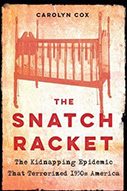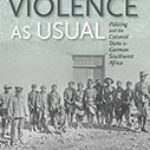The Snatch Racket: The Kidnapping Epidemic That Terrorized 1930s America

Author: Carolyn Cox
Publisher: Lincoln, NE: Potomac Books (an Imprint of the University of Nebraska Press), 2021. 376p.
Reviewer: Paula S. Fass | September 2021
There is a lot to be admired about books written in clear, spunky prose that mimic the lingo of their subjects and offer readers quick glimpses into fascinating criminal enterprises. The Snatch Racket by Carolyn Cox has all of these features. In short chapters that narrate a variety of criminal activities from 1932 to 1935, the book invites us to relive the dangerous period of the early 1930s when gangsters terrorized wealthy Americans through organized kidnappings and other crimes that seemed to make the United States into an increasingly lawless nation. When the “molls” (girlfriends of gangsters) and police corruption are added to the mix, the book becomes a naturally intriguing foray into a historical time and its problems of criminal justice. Cox is well aware of the reader appeal this brew provides. Additionally, and predictably, she has inserted the perpetually fascinating Lindbergh kidnapping as the spicy sugar. At the time of the Lindbergh snatch in 1932, many Americans believed it was the work of an organized criminal gang, with Charles Lindbergh initially among the believers. Indeed, a book also called the Snatch Racket (by journalist Edward Dean Sullivan) was published in 1932. In fact, there is no evidence that Charles Lindbergh, Jr. was the victim of an organized criminal gang.
This said, Cox’s book is not really about the Lindbergh kidnapping, despite the photo of the famous empty crib on the jacket cover; and it is not about criminal gangs either, despite the many lively gangland stores retold in it. It is about the creation of the FBI (Federal Bureau of Investigation) under J. Edgar Hoover, and its growing tentacles into American criminal justice. The racketeers, the Lindbergh snatch, the Barker-Karpis gang, John Dillinger, Al Capone, Bonnie and Clyde, and the Detroit Purple Gang all play their part in the quilt of stories Cox tells here, but the stitching is performed by the increasingly visible hand of Hoover and his G- Men. Their growing power was hardly predictable given the bureau’s scrawny beginnings in the 1920s, nor was it inevitable. Cox shows that each dramatic episode of disorder, broadly publicized by a sensation seeking press, was used by Hoover to gain influence and power both at the highest levels in Washington (including with a newly installed President Franklin Roosevelt) and in local offices through his cadre of loyal agents.
In constructing her book around the more appealing stories of criminals rather than a dreary analysis of a growing bureaucracy, Cox assures herself of a much larger audience. She is also correct to demonstrate how Hoover used contemporary perceptions of these stories to build his domain. But the strategy has its costs. It sometimes hides the deeper story she has to tell. Cox has done her research on the FBI, and has read widely in archival materials. Glimmers of this work are visible in the interstices of this book. As a lawyer herself, Cox is also well aware of the justice stakes involved as a federal agency gains behind the scenes power that eclipses that of other federal agencies, such as the SIU (Special Intelligence Unit at the Bureau of Internal Revenue) and becomes a jealous competitor to local and state policing authorities. Still, the reader out for the headlines may miss the real story. Cox shows, for example, that Hoover explicitly tries to use the Lindbergh case to muscle in on territory from which the FBI was initially excluded, and to grab limelight credit even when it was not due. His agents were even advised to deceive local police by hiding the work of FBI agents at a time when the efforts of the multiple policing agencies were supposed to be coordinated and working together. “Extreme care should be exercised in order that officials of the New Jersey State Police and New York City Police will not be advised of the identity of these agents or the fact that they are working on the Lindbergh case” (p. 232). A careful reader becomes aware of the manipulations taking place, but the jazzy stories tend to render this a distinctly secondary feature of the book.
Its importance to the glory for which the FBI was striving is sometimes visible in the retelling of the Lindbergh case which, while not a product of gangland activity, was, in fact, a lynchpin in the FBI’s evolution from a very minor and largely invisible agency to a powerful part of the federal policing apparatus. Cox largely depends on secondary sources for the story of the famous kidnapping in Hopewell, New Jersey on March 1, 1932 at the recently completed Lindbergh estate—the crime of the century by everyone’s account—as well as the trial and conviction of Bruno Richard Hauptman in Flemington, New Jersey that began on January 2, 1934. Both parts of this story are widely known and have been often retold. She adds little that is new to this narrative. Less well known is how Hoover tried to take charge of the investigation, despite resistance from the important actors who were first on the scene. These included H. Norman Schwartzkopf, the head of the New Jersey State Police, Elmer Irey sent by the Department of the Treasury, and, not least, Charles Lindbergh himself who tried hard to maintain control of the investigation. Cox observes and follows the growing intrusion of the FBI from the time of the crime itself toward its conclusion as the hunt for the kidnapper becomes the heart of the story. But there are so many other criminal cases that intervene between the crime and the punishment, and so many interesting “characters” appear that the reader, for whom the Lindbergh case is not well known, would be excused for losing the thread of the argument. A careful reader should, however, clearly understand that what is tying this book together is not the criminals but their pursuers.
Most readers would also become aware by the end of the book that Cox uses the continuing uncertainty about Hauptmann’s guilt, at least in part to justify its inclusion in a book ostensibly about kidnap gangs. Indeed, the FBI ultimately withdraws from pursuing the case against Hauptmann because Hoover believed the evidence against him was insufficient. That uncertainty continues to make “the crime of the century” the mystery of the century and it remains top of the list among journalists today, as I discovered when I wrote about the case some years ago. Cox admits that she cannot decide either. Like Hoover, she concludes that the evidence was sketchy. Certainly, the most important evidence was gathered not by the FBI, but by local law enforcement who found a crucial connection between the wood in the handmade ladder left at the scene and the wood in Hauptmann’s attic, and found evidence in the tools that Hauptmann, a carpenter, used. Apart from the spiciness of the story, a reader may be permitted to wonder why so much of the book is devoted to the Lindbergh case when the FBI largely failed in its attempt to take it over and made a hasty retreat when the prospects for conviction did not look good.
Still, Hauptmann’s possible innocence is not insignificant in the Snatch Racket. Many writers, past and present, have profited from arguing for Hauptmann’s innocence and Cox continues to hold that out as a possibility, thus keeping the mystery alive. She has also aligned herself with those writers who believe that Lindbergh was complicit in the possible scapegoating of Hauptmann, since Lindbergh identified Hauptmann at the trial (and at the grand jury investigation that preceded it) from his voice. Lindbergh had heard it only once, and very briefly, almost three years earlier when the ransom money was turned over. Given Lindbergh’s stature and renown, that testimony was probably decisive. Cox is only the most recent of a long line of investigators who have held Lindbergh as either guilty of the kidnapping itself or at least guilty of offering false testimony.
Cox implies that the FBI’s failure to be in charge of the successful prosecution in the Lindbergh case led to overkill (literally) in trying to solve other kidnapping cases. Eager to recapture the limelight by nabbing notorious criminals, they went all out, killing the innocent Ma Barker together with the guilty. At best, the evidence presented in this matter, like most of the evidence at the Hauptmann trial, is circumstantial. The story she tells is riveting, but a scholar might want more substantial material and a more attentive analysis. Like so much of the clamoring press at the time, Cox is playing to the appetite of today’s audience for stories about crimes, where police, like criminals, wield their guns with abandon.
At a time when policing is under fire, and the problematic techniques they use with sometimes innocent subjects as well as the treatment of outsiders (Hauptman was an illegal German immigrant) are very much in the news, Cox has found a subject that can capture a wide audience both in its style and its implications about the justice system. She raises a host of questions about this era, concerning justice denied and justice misapplied in regard to the FBI, and about local policing. She also shows how the desire for aggrandizement and power plays a significant part in our criminal justice history. She does this subtly and behind the scenes of her stories. And she makes a good case for our historical shortcomings in pursuing and convicting criminals.
Paula S. Fass, Margaret Byrne Professor of History Emerita, University of California at Berkeley


